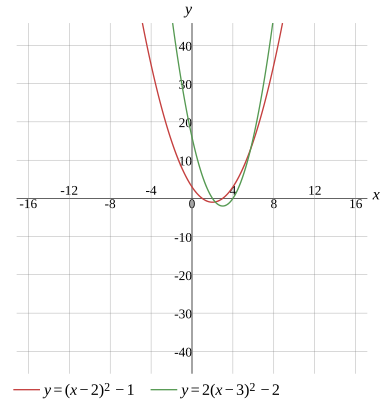Question
(x−2)2−1=2(x−3)2−2
Solve the quadratic equation
Solve using the quadratic formula
Solve by completing the square
Solve using the PQ formula
x1=4−3,x2=4+3
Alternative Form
x1≈2.267949,x2≈5.732051
Evaluate
(x−2)2−1=2(x−3)2−2
Expand the expression
More Steps


Evaluate
(x−2)2−1
Expand the expression
More Steps


Evaluate
(x−2)2
Use (a−b)2=a2−2ab+b2 to expand the expression
x2−2x×2+22
Calculate
x2−4x+4
x2−4x+4−1
Subtract the numbers
x2−4x+3
x2−4x+3=2(x−3)2−2
Expand the expression
More Steps


Evaluate
2(x−3)2−2
Expand the expression
More Steps


Evaluate
2(x−3)2
Expand the expression
2(x2−6x+9)
Apply the distributive property
2x2−2×6x+2×9
Multiply the numbers
2x2−12x+2×9
Multiply the numbers
2x2−12x+18
2x2−12x+18−2
Subtract the numbers
2x2−12x+16
x2−4x+3=2x2−12x+16
Move the expression to the left side
−x2+8x−13=0
Multiply both sides
x2−8x+13=0
Substitute a=1,b=−8 and c=13 into the quadratic formula x=2a−b±b2−4ac
x=28±(−8)2−4×13
Simplify the expression
More Steps


Evaluate
(−8)2−4×13
Multiply the numbers
(−8)2−52
Rewrite the expression
82−52
Evaluate the power
64−52
Subtract the numbers
12
x=28±12
Simplify the radical expression
More Steps


Evaluate
12
Write the expression as a product where the root of one of the factors can be evaluated
4×3
Write the number in exponential form with the base of 2
22×3
The root of a product is equal to the product of the roots of each factor
22×3
Reduce the index of the radical and exponent with 2
23
x=28±23
Separate the equation into 2 possible cases
x=28+23x=28−23
Simplify the expression
More Steps


Evaluate
x=28+23
Divide the terms
More Steps


Evaluate
28+23
Rewrite the expression
22(4+3)
Reduce the fraction
4+3
x=4+3
x=4+3x=28−23
Simplify the expression
More Steps


Evaluate
x=28−23
Divide the terms
More Steps


Evaluate
28−23
Rewrite the expression
22(4−3)
Reduce the fraction
4−3
x=4−3
x=4+3x=4−3
Solution
x1=4−3,x2=4+3
Alternative Form
x1≈2.267949,x2≈5.732051
Show Solution

Graph
